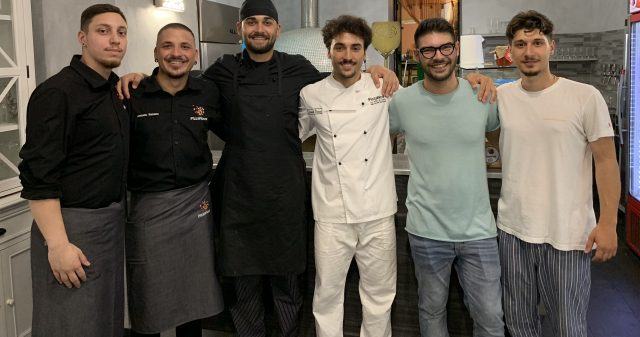A white whisper from the heart of Italy (1): Orvieto
In Renaissance times, ‘Greco’, ‘Grecanico’ and ‘Grechetto’ were generic terms used to indicate wines that were so good they recalled the white wines from Greece. Grechetto, from the area of Orvieto, was a superstar back then and was even praised much earlier by Pliny the Elder in his celebrated Naturalis Historia. In the past it was a light and semi-sweet white wine that was much appreciated in the Papal court that had chosen this lovely city in Umbria, which with its cathedral alone makes it worth a visit today, as an alternative seat to Rome.
Over the centuries the fame of white wine from the area has had its ups and downs, being both acclaimed and forgotten.
Today wine lovers certainly do not think of ‘Orvieto’ when classifying quality wines.
The wine is now only produced as a dry wine, at least those from the leading producers, and for the most part it is made in steel with little if any use of wood. It is a subtle wine with a suspended acidity that never stands out. And since it is never explosive nor too expressive, in a way it is like a great northern wine, Gavi. Both wines could be described as pencil sketches as opposed to an oil painting.
Orvieto today is a perfect table wine, one that is best when not cold (for me it should be served at 14-15°C), and which is easily paired with food thanks to its ability to ‘waken’ its flavors.
It also has an unexpected ability to age.
Experts say Orvieto’s talent comes from the soil in the area, while almost no one mentions the microclimate offered by the nearby lakes, especially Lake Corbara which s in the heart of the classic appellation.
Curiosity and some excellent bottles inspired us to visit the Decugnano dei Bardi estate, the wine’s guiding light, where the vineyards are on a hill with full exposure and at an altitude of 300m above sea level.
Wine has been made here since the time of the Etruscans, who carved the cellars out of sandstone, and for centuries the estate was owned by the Orvieto Curia. Decugnano acquired by the Barbi family in 1973 and it is run today by Enzi Barbi who, despite his young age (he was born in 1980), is a seasoned and authoritative winemaker.
‘’I am a just a winemaker. Colleagues of my own age talk about and believe in going back to the roots, forgetting that one cannot ignore the present and future. The farmers of the past lived a life that has nothing to do with ours today. For them farming was not a choice. There is no such thing as an agricultural Disneyland where the message, in other words the producer, is more important that the product, wine’’.
It should come as no surprise to know that Enzo is also the current president of the Orvieto producers association.
Doctor Wine: When people talk about Orvieto they always seem to focus on the soil. What about Lake Corbara?
Enzi Barbi: Good point. Unfortunately, I don’t have an answer, since when I came the (artificial) lake was already there. In any case, there is no doubt that proximity to the lake helps develop noble rot.
DW: Orvieto’s image does not correspond with the qualities it can express, at least for the wines from the best producers. Is this the fault of outside bottlers?
EB: It’s impossible to generalize. More than the bottlers a distinction must be made between the winemakers, who often produce good wines, and the blenders, a post-war role that still exists today. It must not be forgotten that Orvieto’s fame came from two bottlers operating outside the area, Antinori and Ruffino. They are the ones who broke into the American market. In a way, Orvieto is similar in this way to Soave, which in recent years has also been getting better. Nevertheless, the top local producers are now getting their just recognition. On the market today there are at least a dozen Orvieto wines that are really good.
DW: How is the market today?
EB: In my view we Italians are commercially overrating the market. Everything is based on advertising and this because there is no direct connection with Italian cuisine to make Italian wines better known. Restaurants are what best promote Italian wines, everywhere. The Chinese do not love wine, except the strong and colored reds and this because what they love is alcohol and color. Wine has not become part of their rituals. What I have personally witnessed there is that the great Chateau wines are given as company gifts and are rarely consumed at the table.
DW: Is the secret to Orvieto the tufa soil?
E: The terroir of Orvieto is not geologically uniform. The southern area has a volcanic soil and the whites produced there have a minerality that leans towards flint. The central area, on the other hand, has a clay soil which brings out the floral component. The soil in the north, on the right bank of the Paglia River, where Decugnano is located, is sandy. The wine from here has a minerality that is less sulfurous and more brackish. Our soil has dark sand of one Pliocene origin, full of fossil shells that you can see with the naked eye.
DW: What methods do you employ in the winery?
EB: The normal ones for white wine with some brief, cold maceration. We use select yeasts since the sulfur level is so low. That’s about it.
DW: Orvieto used to be a semi-sweet wine.
EB: And for a very simple reason: the indigenous yeasts then could not complete fermentation. Noble rot had nothing to do with it. Fifty years ago winegrowers could not distinguish it between the gray mold. The use of noble rot is recent, the result of the success of Antinori’s Muffato della Sala as well as the creation of Lake Corbara.

 Italiano
Italiano








